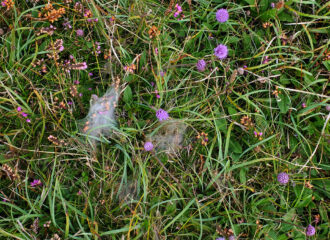The maritime heath habitat is typically found on sloping coasts very close to the sea. It is distinguished from dry heaths, which can be found within metres, by low-growing swards with ling (Calluna vulgaris) forming more than 25% vegetation cover, an abundance of spring squill (Scilla verna) and an absence of gorse (Ulex spp). The EU Habitats Directive includes maritime heaths in ‘Vegetated sea cliffs’ habitat class rather than the ‘European dry heaths’ class. The extent of the habitat is influenced by the extent of salt deposition during winter storms, which determines the area available both to spring squill and gorse. Intensive sheep-grazing is a threat to this habitat and can result in the removal of the ericoid components.
Maritime heath

Reference state 1 – Maritime heath with abundant devil’s-bit scabious and marsh fritillary butterflies
This form of maritime heath, with abundant devil’s-bit scabious (Succisa pratensis) can host large colonies of the marsh fritillary butterfly (Euphydryas aurinia). The scabious is the food plant for the marsh fritillary caterpillars and the larval webs of the butterfly (seen in the image here) can be abundant in good years.

